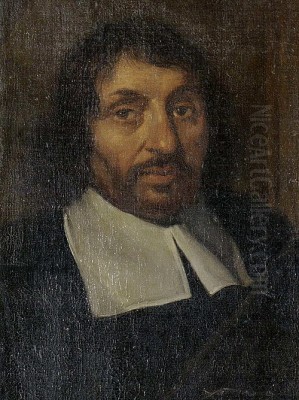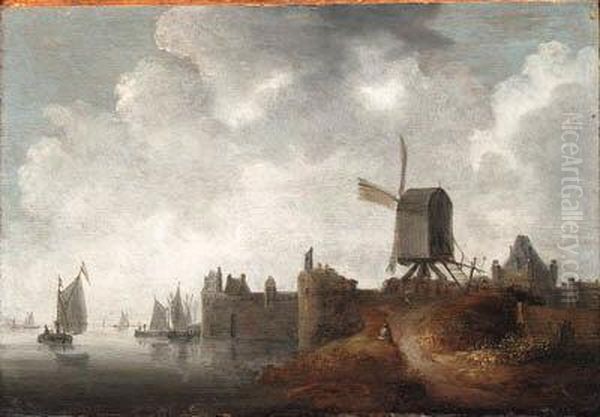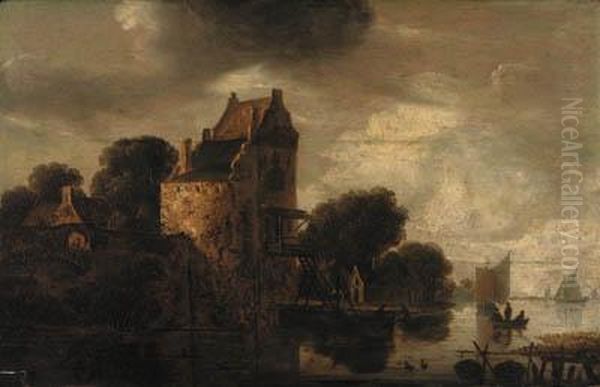
Wouter Knijff stands as a notable figure within the rich tapestry of Dutch Golden Age painting. Active during the 17th century, a period of extraordinary artistic flourishing in the Netherlands, Knijff dedicated his career primarily to the genres of landscape and seascape painting. His Dutch nationality is firmly established, and his professional identity is that of a painter who contributed significantly to the visual culture of his time. Born in 1607 and passing away in 1693, his long life spanned a crucial era in the development of Dutch art, witnessing the rise and evolution of landscape painting as a major independent genre.
Knijff's work is particularly recognized for its connection to the style of one of the era's giants, Jan van Goyen. He is often described as a follower or imitator of Van Goyen, absorbing the master's approach to composition, atmosphere, and palette. This association places Knijff squarely within the mainstream of Dutch landscape painting during the mid-17th century, a time when artists increasingly turned their attention to capturing the specific light, atmosphere, and topography of their native land. His contributions earned him recognition within artistic circles, including membership in the Hague School and a position within the art establishment of his time.
Origins and Early Life
Wouter Knijff was born in 1607 in Wesel, a town located in present-day Germany but historically having strong ties with the Netherlands, particularly during the period of the Dutch Republic. While details about his earliest years and initial training remain somewhat scarce, his emergence as an artist occurred during a time when the Dutch Republic was experiencing unprecedented economic prosperity and cultural confidence. This environment fostered a burgeoning art market, creating opportunities for artists specializing in various genres, including the increasingly popular landscape.

The early 17th century Netherlands saw a shift in artistic patronage and subject matter. With the decline of church commissions following the Reformation and a growing affluent merchant class, demand surged for smaller-scale paintings suitable for domestic interiors. Portraits, genre scenes, still lifes, and landscapes became highly sought after. Knijff entered this dynamic art world, choosing to specialize in views of the Dutch land and sea, subjects that resonated deeply with national pride and the everyday experiences of the Dutch people. His birthplace, Wesel, though outside the core provinces, was part of this broader cultural sphere.
Artistic Training and the Influence of Jan van Goyen
The most defining aspect of Wouter Knijff's artistic formation and style is his relationship with Jan van Goyen (1596–1656). Knijff is consistently identified as a student and close follower of this highly influential master. Van Goyen was a pioneer of the "tonal" phase of Dutch landscape painting, which emerged in the late 1620s and dominated the following decades. This style prioritized atmospheric unity and naturalism, achieved through a restricted palette of browns, grays, greens, and yellows, subtle tonal gradations, and compositions often featuring low horizons and expansive, cloud-filled skies.
Knijff thoroughly absorbed Van Goyen's techniques and thematic concerns. His landscapes and seascapes often exhibit the characteristic features of Van Goyen's work: diagonal compositions leading the eye into the distance, a focus on water (rivers, estuaries, canals), humble rural buildings, windmills, and small figures that animate the scene but remain subordinate to the overall landscape. The emphasis was on capturing the moist, hazy atmosphere and the specific quality of light found in the Dutch environment. This dedication to Van Goyen's manner was so pronounced that Knijff is often termed an "imitator," suggesting a deliberate emulation rather than merely passive influence.
While Van Goyen was a dominant force, the development of tonal landscape painting also involved other key figures like Esaias van de Velde (c. 1587–1630), who was briefly Van Goyen's teacher, and Pieter de Molijn (1595–1661). Knijff's work should be understood within this broader movement that sought a more naturalistic and atmospheric depiction of the local scenery, moving away from the more colorful and detailed styles of earlier Flemish and Dutch landscape traditions, such as those seen in the work of artists like Pieter Bruegel the Elder or later, Pieter Bruegel the Younger. Knijff’s commitment to the tonal style places him alongside contemporaries who explored similar paths, such as Salomon van Ruysdael (1602–1670), another master of atmospheric river scenes.
Artistic Style, Themes, and Representative Works

Wouter Knijff's oeuvre primarily consists of landscapes and seascapes, reflecting the prevailing tastes of the Dutch Golden Age market. His works typically depict scenes familiar to the Dutch populace: tranquil rivers winding through flat countryside, bustling estuaries dotted with sailing vessels, coastal views under expansive skies, and villages nestled along waterways. A recurring theme in his work is the depiction of river views featuring architectural elements – perhaps fortifications, town walls, or prominent buildings along the banks. One such representative work type is known generally as River views with architecture.
His style is characterized by the hallmarks of the tonal school, heavily influenced by Jan van Goyen. Knijff employed a relatively subdued palette, favoring browns, ochres, grays, and greens to create a sense of atmospheric unity and depth. His brushwork, while perhaps not always possessing the same fluidity as Van Goyen's, aimed for a similar effect of capturing light and air. Compositions are often carefully constructed, frequently using diagonals – a riverbank, a road, a line of boats – to draw the viewer's eye into the scene. Skies typically dominate a large portion of the canvas, reflecting the importance of weather and light in the Dutch landscape.
Knijff paid considerable attention to detail within his broader atmospheric framework. Buildings are rendered with enough specificity to be recognizable, boats are depicted with an understanding of their structure and rigging, and small figures are often included to add life and scale to the scenes. These figures – fishermen, travelers, townspeople – contribute to the realistic portrayal of everyday life within the landscape. Works like Seacoast exemplify his engagement with maritime themes, capturing the interplay of water, land, and sky along the Dutch coastline.
While deeply indebted to Van Goyen, Knijff developed his own recognizable hand. Art historians note subtle differences, perhaps in the handling of foliage, the rendering of architecture, or the specific atmospheric quality. His works stand as competent and often charming examples of mid-17th-century Dutch landscape painting. They contrast with the more dramatic and monumental landscapes that would be developed later in the century by artists like Jacob van Ruisdael (c. 1629–1682), or the sunnier, more Italianate landscapes of painters like Aelbert Cuyp (1620–1691) in his later phases. Knijff remained largely faithful to the tonal aesthetic pioneered in the preceding decades.
Some works attributed to Knijff bear signatures or monograms, though attributions can sometimes be complex, especially given the prevalence of workshop practices and imitation during the period. The mention of works signed "VG" but identified as not being by Van Goyen might allude to the challenges of distinguishing between the master, his followers, and potential imitators or forgers, although the provided text suggests these "VG" signatures on Knijff-like works specifically point away from Van Goyen, perhaps indicating another artist or a misunderstanding in the source interpretation. Knijff typically signed with his own name or monogram.
Professional Life and Guild Affiliation
Wouter Knijff was an active participant in the professional structures of the Dutch art world. He is identified as a member of the Hague School, indicating his connection to the artistic community in that important administrative and artistic center. Furthermore, records indicate his involvement with the painters' guilds, which were crucial organizations for regulating the trade, training apprentices, and maintaining quality standards.
The provided information mentions Knijff becoming an "official" in 1675. There appears to be some ambiguity in the source texts regarding the location: one mention refers to him becoming an official of the "Hague Gallery" (perhaps meaning the Confrerie Pictura, The Hague's guild-like organization founded in 1656), while another mentions him becoming an official of the "Haarlem Guild" (the Guild of Saint Luke). Haarlem was another major artistic center, and Jan van Goyen himself worked there for a period. Given that Knijff's son Jacob was active in Haarlem and that the anecdote section specifically mentions the Haarlem Guild role, it's plausible he held a position there. Becoming an official (such as a deken or hoofdman) signified respect and standing within the artistic community.
Membership and roles within these guilds were important markers of professional status. They provided artists with the legal right to practice their trade, sell their works, and take on pupils within a specific city. Knijff's documented position as an official underscores that he was a recognized and respected master craftsman in his later career, contributing not only through his paintings but also through participation in the governance of his profession. This status reflects a successful career within the competitive art market of the Dutch Golden Age.
A Family of Artists
Wouter Knijff was not the only painter in his family; indeed, he appears to have been the patriarch of a minor artistic dynasty. Several of his sons followed him into the profession, specializing, like their father, in landscape and marine painting. This continuation of a trade within a family was common during the period, with skills and workshop practices often passed down through generations.
His most well-known son was Jacob Knyff (or Knijff, 1639–1681). Jacob also became a painter of landscapes and seascapes, initially working in the Netherlands. He later moved to England around 1673, where he enjoyed patronage and success, particularly known for his detailed topographical views of country houses and estates, as well as marine paintings. Jacob's international career suggests a level of ambition and adaptability. It is also noted that while in Paris, Jacob Knyff taught the artist Johannes Gottlieb Glauber (1656–1703), indicating his own role as a master passing on artistic knowledge.
Wouter had other sons who were also painters: Willem Knijff and Leonard Knijff (also spelled Leendert, c. 1650–1722). Leendert Knyff also moved to England, arriving around the same time or shortly after his brother Jacob. Leendert became known primarily for his paintings and drawings of birds, country estates, and animals, often working for the English aristocracy. The collective activity of Wouter and his sons Jacob, Willem, and Leonard demonstrates a significant familial engagement with the arts, particularly landscape and related genres, spanning several decades and even crossing national borders.
Furthermore, Wouter Knijff had an artistic connection through his own family. He was depicted in a painting of Saint Luke (the patron saint of painters) by his brother, Dirck de Bray (c. 1635–1694). Dirck de Bray was part of another notable Haarlem family of artists, primarily known as a painter of still lifes and portraits, as well as an etcher and woodcutter. This inclusion in a work by his brother visually confirms Wouter's place within the artistic fraternity of Haarlem, positioning him alongside other practitioners in a symbolic representation of their craft.
Contemporaries and the Artistic Milieu
Wouter Knijff worked during a period of intense artistic production in the Netherlands. The sheer number of painters active during the Dutch Golden Age is staggering, and the market supported a high degree of specialization. In the field of landscape painting alone, Knijff had numerous contemporaries, ranging from his influential teacher Jan van Goyen to other masters who developed distinct styles.
Besides Van Goyen and Salomon van Ruysdael, whose tonal approaches were closest to Knijff's, the landscape genre saw diverse developments. Jacob van Ruisdael emerged as perhaps the most influential landscape painter of the second half of the century, known for his more dramatic, heroic, and often symbolically charged depictions of nature. His student, Meindert Hobbema (1638–1709), specialized in charming woodland scenes. Philips Koninck (1619–1688) became famous for his expansive panoramic landscapes, offering wide vistas under dramatic skies.
Painters like Aelbert Cuyp developed a different sensibility, often suffusing their landscapes with a warm, golden, Italianate light, particularly in depictions of cattle and pastoral scenes along the rivers near Dordrecht. Earlier figures like Hercules Segers (c. 1589/90–c. 1633/38) had experimented with highly imaginative and unconventional landscapes. Knijff’s work, therefore, represents one specific but significant trend within this diverse field – the realistic, atmospheric depiction of the local Dutch environment, rendered in the popular tonal style.
The existence of numerous artists working in similar styles, like Knijff following Van Goyen, highlights the competitive nature of the art market and the ways styles could be disseminated and adapted. Artists often influenced one another through direct teaching, workshop collaborations, guild memberships, and simply by observing the works available for sale. Knijff's career unfolded within this vibrant, complex network of artistic production, competition, and influence.
Legacy and Historical Evaluation
Wouter Knijff is regarded as a competent and characteristic painter of the Dutch Golden Age, particularly representative of the tonal landscape tradition established by Jan van Goyen. His historical significance lies primarily in his role as a skilled practitioner within this influential movement and as a conduit for this style, both through his own works and potentially through the initial training of his artist sons. He successfully navigated the 17th-century Dutch art market, achieving professional recognition through his guild activities.
His artistic legacy is somewhat nuanced. While recognized as an important follower of Van Goyen, his work is often seen as less innovative than that of his master or other leading landscape painters of the era like Jacob van Ruisdael. The description of him as an "imitator," while acknowledging his skill in adopting Van Goyen's style, also implicitly positions him as less original. This perception might contribute to why his works, according to the provided text, have sometimes fetched lower prices on the art market, potentially compounded by the existence of numerous contemporary copies or works in a similar vein that complicate attributions.
However, his contribution should not be understated. Knijff produced a substantial body of work that captures the specific atmosphere and appearance of the 17th-century Dutch landscape. His paintings offer valuable visual documents of the era's waterways, towns, and coastal areas. Furthermore, the continuation of artistic practice through his sons, Jacob and Leendert Knyff, who achieved success both in the Netherlands and England, points to a lasting familial impact on the art world, extending his influence beyond his own canvases.
His works are held in various museum collections, allowing contemporary audiences to appreciate his skill in rendering atmospheric effects and detailed observation. He remains a figure studied by art historians specializing in the Dutch Golden Age, valued for his representation of the Van Goyen school and for his place within the broader context of 17th-century Dutch art and society. Wouter Knijff exemplifies the many skilled artists who contributed to the depth and richness of the Dutch Golden Age, even if not reaching the pinnacle of fame occupied by figures like Rembrandt, Vermeer, or the Ruisdaels.
Conclusion
Wouter Knijff remains a significant figure for understanding the breadth and depth of Dutch Golden Age landscape painting. As a dedicated follower of Jan van Goyen, he mastered the tonal style, creating atmospheric and detailed views of the Netherlands' distinctive land and waterscapes. His long career, professional standing within the guild system, and role as the head of an artistic family underscore his successful integration into the vibrant art world of the 17th century. While perhaps overshadowed in innovation by some contemporaries, his works endure as fine examples of their genre and period, offering valuable insights into the artistic tastes and visual environment of the Dutch Republic during its most celebrated artistic era. His legacy persists through his paintings and the subsequent careers of his talented sons.